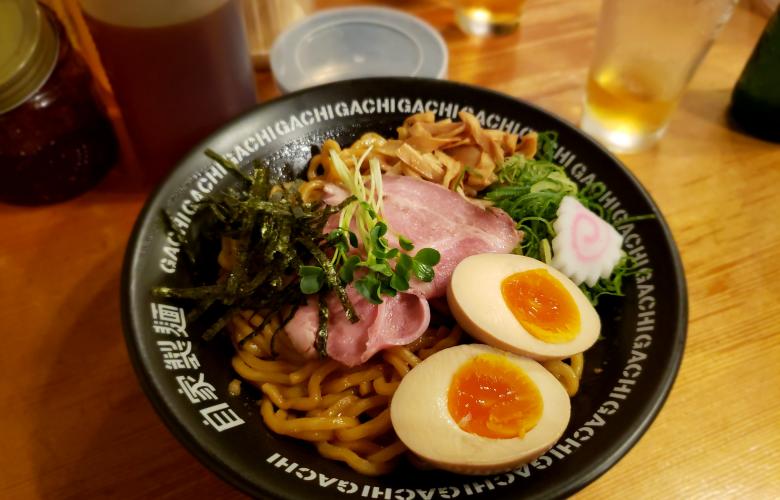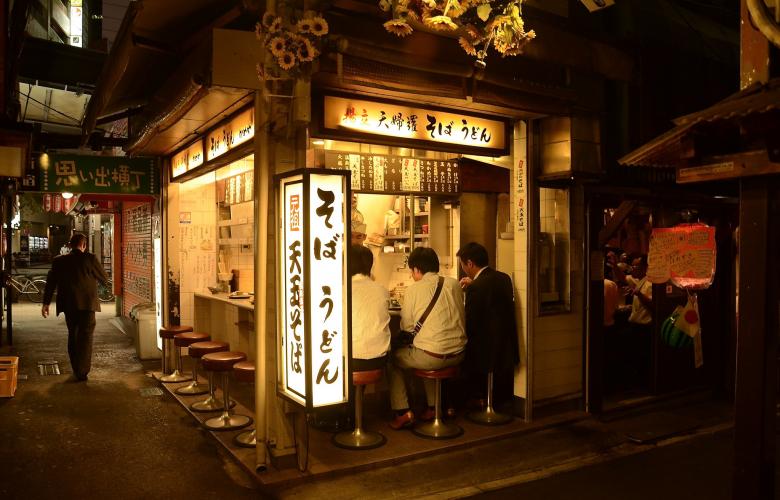Six of Tokyo's best foodie neighbourhoods
Contact
Six of Tokyo's best foodie neighbourhoods
From rich, late-night ramen to lengthy multi-course kaiseki meals, Tokyo is renowned for a food scene that’s bursting at the seams.
While Osaka may be known as Japan’s kitchen, Tokyo is the restaurant capital of the world, with over 160,000 places to choose from. Seating anywhere from four to 400 diners, restaurants come in all shapes and sizes and with all manner of dishes. Unlike many countries, in Japan a restaurant will often specialise in a single meal or style — ramen, for example, or Kansai-favourite okonomiyaki. Honing a recipe for decades, chefs will focus on their select ingredients, cooking style and service — all to create a unique and highly crafted dining experience.
While every street and alley in Tokyo will have a dozen choices, there are certain areas with a particular reputation, and if you’re here for the food, you might as well try the best.
1. Ginza: Michelin-star sushi and soba
The classy neighbourhood lined with designer brand stores and luxury labels, Ginza doesn’t let the food front slide either. Here you’ll find two of the city’s three sushi restaurants awarded the maximum of three Michelin stars (plus three with two stars and plenty of one-star joints too). While reservations at top-tier restaurants like Sukibayashi Jiro and Sushi Yoshitake are hard to get, there are plenty of high-quality alternatives nearby. The area is also home to international Michelin-star spots, like Italian restaurant Aroma Fresca, and has a reputation for soba (head to Soba Sasuga if you’re craving delicious buckwheat noodles).
2. Shibuya and Shinjuku: Ramen, yakitori alleys and drinking holes
Business hubs with plenty of salarymen to serve, Shinjuku and Shibuya are perfect for late-night eats. Favouring quick-to-serve dishes like ramen along with drinking-partner treats like yakitori, you can easily spend a night enjoying the atmosphere. Still with an everyday, old-fashioned scruffiness to them, the two areas have plenty of narrow ramen joints open late into the night as well as Showa-era drinking spots like Golden Gai and Omoide Yokocho. These tightly packed alleys host hundreds and dozens of bars respectively, and while Golden Gai focuses more on drinking, the latter mixes in plenty of yakitori options too. Be prepared to get up close and personal with your smoking neighbours in smokey bars — it’s a step back in time.
3. Tsukishima: The Tokyo speciality of monjayaki
A quiet neighbourhood with a special reputation, Tsukishima is known for the Tokyo speciality of monjayaki. The Kanto version of Kansai’s okonomiyaki, this dish is prepared on a griddle with a savoury pancake-like batter along with cabbage and countless optional toppings. Along Tsukishima Monja Street you’ll find dozens of restaurants all offering hot griddles ready for your choice of monja, okonomiyaki or yakisoba. Part of the fun here is cooking your own food, although some places will do this for you (they’ll all be happy to teach you though). Perfect for social dinners or dates, the local specialty is a great spot for an unusual dinner.
4. Shin-Okubo: Korean delights
The Korean corner of Tokyo, Shin-Okubo has more than skincare and K-pop paraphernalia to keep you entertained. The growing popularity of Korean hot pots and dak galbi (often with tempting lashings of cheese) is perfect for those missing that spicy kick Japanese food lacks. Staples like kimchi, jijimi (pancakes) and hearty bowls of bibimbap can also be found here along with the ubiquitous Korean BBQ that often has an all-you-can-eat option perfect for a long dinner. More unusual options like Korean-style fried chicken and kimbap (like sushi but using different seasonings) are easy to find here too, so get exploring!
5. Ryogoku: Sumo-sized portions of ancient dishes
The heart of Tokyo’s sumo scene, Ryogoku is the place to be is you want to indulge like a wrestler. Plenty of restaurants here specialise in the sumo stew of chanko nabe. Protein-heavy and packed full of vegetables, the stew uses a light broth and is pretty healthy. Perfect for building up energy and muscle, the stew is served in large portions to fighters, but visitors can order slightly more manageable versions too. Pair this with a morning watching sumo training sessions (free) or a day at the annual tournaments and you’re part way to becoming a sumo wrestler yourself.
6. Tsukiji: Still the heart of Tokyo’s seafood scene
Despite losing the famous market in 2018, Tsukiji has retained its reputation for the best fish and seafood in Tokyo. While many of the inner-market traders were forced to move to Toyosu, the outer market remained, as did the strong bonds between traders and local restaurants. Still getting their daily deliveries, local sushi, tempura and izakaya restaurants continue to serve delicious fish-focused meals. Whether you’re after freshly cut sashimi or an izakaya with seasonal snacks to pair with your beer, you’ll not be short of suggestions here — just wander the alleys and see what takes your fancy
By Lily Crossley-Baxter
Similar to this:
Going solo: The Japanese preference for living alone






